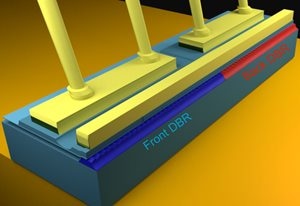Jun 4 2019
Scientists have created a new method of operating miniature quantum cascade lasers (QCLs) to quickly determine the absorption spectra of various organic molecules in the air at the same time.
 Schematic drawing of an extended tuning quantum cascade laser. (Image credit: Alpes Lasers)
Schematic drawing of an extended tuning quantum cascade laser. (Image credit: Alpes Lasers)
The methods provide a sensitive technique for identifying low concentrations of volatile organic compounds (VOCs), enhancing the potential to monitor how these compounds impact human health, industrial processes, and ambient air quality. In addition, the new system could enhance the reliability of breath alcohol tests by more selectively differentiating between ethanol and the other gases people breathe out.
QCLs are composed of multiple layers of semiconductors arranged to improve photon emissions by making use of quantum effects. The scientists developed a QCL-based setup that measures compounds absorbing electromagnetic radiation across a broad spectrum using a single laser, a task that would have earlier required multiple lasers working collectively.
VOCs are generally present in vehicle exhaust, solvents, building materials, and several other products. They can be detrimental to people and ecosystems, and they contribute to tropospheric ozone production and global warming. Real-time techniques to spot and monitor VOCs are of significance for pollution and climate scientists, public health organizations, manufacturers, first responders, and shippers, among others.
The new system, based on an electrically tunable infrared laser without mechanical parts, offers adequate precision and scans a sufficiently broad range of optical frequencies to simultaneously identify many species that are present and determine their concentrations. The Switzerland-based scientists, headed by Lukas Emmenegger of Empa, a materials science and technology institute, will explain their new technique at The Optical Society’s Optical Sensors and Sensing Congress, which will be held from 25th to 27th June in San Jose, California, during Sensors Expo 2019.
Opening Narrow Windows onto a Broad Spectrum
In contrast to detecting a single chemical compound, identifying the different species within VOCs requires dialing the QCL’s optical output across a very wide range of frequencies. To achieve this, the scientists used a comparatively new type of QCL, optimized to be adjustable across a wider frequency range when compared to typical emission frequency range, called a Very Large Tuning QCL (QC-XT), and powered the device in an intermittent mode to increase optical tuning and decrease the laser’s energy consumption.
Later, they presented the main innovation of the new method: By heating the front or back mirror of the laser with short pulses of electrical current, they identified that they could choose the span of frequencies the laser would generate by the so-called Vernier effect.
With the help of this method, the setup basically moves through numerous channels of observation along the molecule’s absorption spectrum in which precise details can be measured and compared to established spectral features, providing almost continuous coverage across a broad frequency range with great accuracy.
The rapid switching between different channels of the QCL offers unprecedented real-time selectivity and sensitivity for the detection of VOCs. High-precision VOC measurements are currently dominated by classical methods, such as gas chromatography or mass spectrometry. Combining the high spectral resolution of well-established distributed-feedback QCLs with the multi-channel capacity of QC-XT may become a game-changer in the field of VOC analysis.
Lukas Emmenegger, Research Head, Empa
Fast and Sensitive Detection
This new analytical approach contributes itself specifically well to quick recognition of widely spaced spectral features of VOCs. To test the technique, the team employed their new setup to simultaneously determine the infrared spectra of a mixture of ethanol, methanol, and acetaldehyde.
The demonstration indicated that the technique successfully differentiates each molecular species from the others and is quick and sensitive. A round of measurements through six different spectral channels took a total of 18 ms. Although individual channels are scanned at an extremely high spectral resolution within just 50 µs, most of the time is spent on changing the electrical heating of the laser components to choose the next channel location along the spectra.
The system evaluated molecular concentrations as low as 50 parts per million with a precision of 50 parts per billion. With extra work, the scientists hope that the system could obtain even greater sensitivity.
Improving Breath Analysis
Besides being ready for a range of applications in environmental and occupational VOC detection, the new system could find application in medical breath analysis or to enhance existing standards for the measurement of breath alcohol content.
In a paper reported on February 12th in The Optical Society’s journal Optics Express, the Empa team reports the detection of airborne alcohol at concentrations as low as 9 parts per billion using a QCL. These outcomes imply that use of QCL laser-based spectrometers for breath alcohol analysis may provide a direction to globally enhanced reliability and standardization of the world’s most frequent forensic test, state scientists.
The work included partners from MIRO Analytical Technologies in Dübendorf and Alpes Lasers SA in St-Blaise.